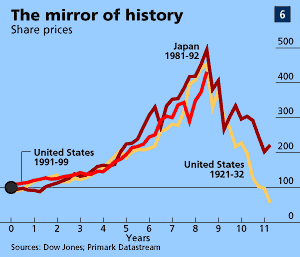Wall Street
Japan
New Era
Home

Bonfire of the insanities
The Economist, September 25, 1999
SURVEY THE WORLD ECONOMY
Some economists believe that there is no such thing as a bubble because markets are always rational and efficient. But history suggests otherwise. In their time, tulips, canals, railways, gold, silver, property and share prices have all bubbled up and then gone “pop”. Each time investors convince themselves that this time it will be different. It never is.
The craziest bubble of all time was tulipmania in the Netherlands in the 1630s. Tulip bulbs, newly arrived from Turkey, became wildly fashionable, and prices soared. At the height of the mania, speculators paid 5,500 florins (equivalent to more than $50,000 in today’s money) for a single rare bulb.
Charles Mackay, in his classic 1841 book “Extraordinary Popular Delusions and the Madness of Crowds”, tells how one unfortunate sailor, who was rather partial to onions, was sent down to a rich man’s kitchen for breakfast, and ate a tulip bulb worth 3,000 florins by mistake. He ended up in prison, but at least he had a good laugh a year later when prices plunged and bulbs became virtually worthless.
Another infamous example was the South Sea Bubble in 1720. The London-based South Sea Company came up with an ingenious plan to take over Britain’s national debt in return for interest and sole trading rights to the South Seas (South America) and hence, in theory, access to the treasures of the gold and silver mines in Peru and Mexico.
The snag was that Spain already controlled those trading rights, which made it difficult for the company to generate profits. Even so, speculators frantically bid up the share price. It rocketed from £130 to £1,000 within seven months, then collapsed abruptly, leaving many investors ruined and landing the chancellor of the exchequer of the day in prison.
Even Sir Isaac Newton averted his gaze from the stars for long enough to buy some shares and make a profit, then buy some more and lose a packet. His comment? “I can calculate the motion of heavenly bodies, but not the madness of people.”
Every time a bubble appears it looks different, but there are common features. James Grant, the editor of a New York-based financial newsletter, says the basis of bubbles is usually one part fundamental (eg, a technological revolution), one part financial (an explosion of cheap credit) and one part psychological (a suspension of traditional valuation norms).
Rising prices draw in ever more investors, all convinced that prices will go on rising. Charles Kindleberger, an American economist, put it nicely: “There is nothing so disturbing to one’s well-being and judgment as to see a friend getting richer.”